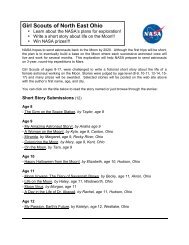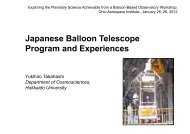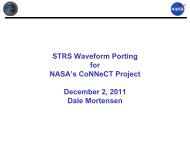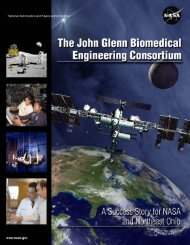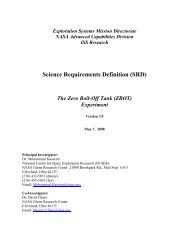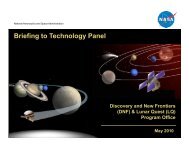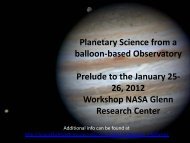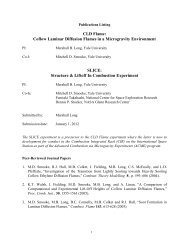Amusement Park Physics With a NASA Twist - Space Flight Systems ...
Amusement Park Physics With a NASA Twist - Space Flight Systems ...
Amusement Park Physics With a NASA Twist - Space Flight Systems ...
Create successful ePaper yourself
Turn your PDF publications into a flip-book with our unique Google optimized e-Paper software.
combustion to fluids, to experimental designs. The <strong>NASA</strong><br />
Glenn Research Center has two drop facilities. One provides<br />
a 132-meter drop into a hole in the ground creating a<br />
microgravity environment for 5.2 seconds. The other facility, a<br />
24-meter tower, allows for 2.2 seconds of microgravity. One<br />
can experience falling by riding on drop rides such as the<br />
Demon Drop (22 meters high) and the Power Tower (73<br />
meters high). Both of these rides are at the Cedar Point<br />
<strong>Amusement</strong> <strong>Park</strong> in Sandusky, Ohio.<br />
The longest drop time available to researchers at this time is<br />
10 seconds, achieved at a 490-meter underground drop shaft<br />
in Japan. This drop tower, which is deeper than the Empire<br />
State Building is tall, has a drop distance of 381 meters or<br />
1250 feet!<br />
High-g Loads<br />
An ideal microgravity environment for research is in the<br />
Earth’s orbit. A main difference between an orbiting spacecraft,<br />
such as the space shuttle, the International <strong>Space</strong><br />
Station, and the drop towers is the length of time for the<br />
microgravity condition. The similarity is that the microgravity<br />
condition is achieved the same way in orbit as it is in the drop<br />
towers or even the drop rides at the amusement park—by<br />
free fall. It is a common misconception that astronauts float<br />
around in the shuttle because there is no gravity in space.<br />
What really makes them float is the fact that spacecraft, and<br />
the astronauts in it, are falling around Earth.<br />
Washing machine<br />
spin cycle<br />
Fighter jet<br />
Loop roller coasters<br />
Shuttle takeoff<br />
Commercial aircraft<br />
on takeoff<br />
up to 163 g<br />
up to 10 g<br />
up to 3.7 g<br />
up to 3 g<br />
up to 1.5 g<br />
High-g Loads<br />
The gravitational pull towards Earth never changes. However,<br />
just as weightless sensations can be created by<br />
certain motions on Earth, so can the feeling of heaviness.<br />
When a person’s apparent weight is heavier than his or her<br />
actual weight, he or she is experiencing what is called high-g<br />
forces. These high-g forces can happen because of an<br />
increase in gravitational force, an acceleration away from<br />
Earth, or horizontal circular motions. One doesn’t have to<br />
look too far at the amusement park to find high-g force<br />
experiences. On the roller coaster the rider feels pressed<br />
into his or her seat as the car hits the bottom of a hill or<br />
bends around a sharp curve. Some free-fall rides shoot up<br />
into the air, in which case the rider feels as if he or she is<br />
getting pushed into his or her seat. One feels high-g forces<br />
in these situations because the direction and/or speed of the<br />
ride is changing in just the right way.<br />
24<br />
<strong>Amusement</strong> <strong>Park</strong> <strong>Physics</strong> <strong>With</strong> a <strong>NASA</strong> <strong>Twist</strong><br />
EG–2003–03–010–GRC



